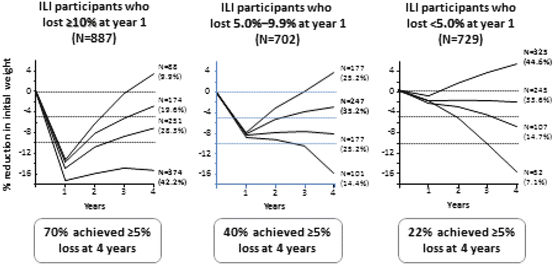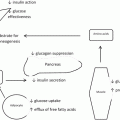Fig. 4.1
Weight loss in Look AHEAD over minimum 8 years of observation. Mean (+SE) weight loss from baseline among participants in the Intensive Lifestyle Intervention (ILI; n = 2570) and Diabetes Support and Education (DSE; n = 2575). Differences between groups are significant (P < 0.001 for all years). The between-group difference in weight loss after 8 years minimum follow-up was 2.6 %
In terms of predictors of success over the long term, a 4 years analysis of patterns associated with success again revealed that attendance at counseling sessions and amount of physical activity were related to 4 years weight loss in a graded fashion with greater adherence translating into more weight loss [12]. However, for participants in the Intensive Lifestyle Intervention, initial weight loss was a strong predictor of ultimate weight loss [12]. This is illustrated graphically in Fig. 4.2, which shows that weight loss at year 1 was predictive of ability to achieve significant weight loss at year 4. The initial weight loss was highly variable in year 1, with roughly one-third achieving 5 % loss or less, one-third achieving 5–9.9 % loss and one-third achieving ≥10 % loss. If one looks at ≥5 % weight loss at year 4, 70 % of those who achieve ≥10 % in year 1 meet this benchmark at year 4, while only 40 % of those who lost 5–9.9 % in year 1 did and only 22 % of those who lost less than 5 % at year 1 did so. Clearly, initial weight loss is important, because it is predictive of ultimate weight loss.


Fig. 4.2
Weight loss (percent loss from baseline) at 1 year in Look AHEAD predicts probability of clinically significant weight loss at 4 years. Participants in the Intensive Lifestyle Intervention (ILI) were categorized according to 1 year loss. The proportion who achieved ≥10 %, 5–9.9 %, and <5 % were, respectively, 38, 30, and 31 %. Of those who lost ≥10 % in year 1, 70 % achieved 5 % or more weight loss in year 4. Of those who lost 5–9.9 % in year 1, 40 % achieved 5 % or more weight loss in year 4. Of those who achieved <5 % in year 1, only 22 % achieved 5 % or more loss at year 4 [12]
We will use the Look AHEAD study and the weight loss achieved and sustained over the 1, 4, and 8 years of observation to demonstrate effects on metabolic risk factors, symptoms, and functional issues in patients with type 2 diabetes.
2.
What is the effect of weight loss achieved with lifestyle intervention on glycemic measures, cardiovascular risk factors, and concomitant medication use in persons with type 2 diabetes? The impact of negative energy balance on glycemia is immediate. But once weight loss has reached a plateau, and weight is stable there is a strong effect on glycemia of even modest weight loss, such as was achieved in Look AHEAD. As demonstrated in Table 4.1, the glycemic changes associated with weight loss at years 1 [10] and 4 [11] demonstrated clinically significant reductions in hemoglobin A1c for those who were in the intensive lifestyle intervention, both at year 1 and at year 4. This improvement occurred in the presence of lesser medication use. Of patients who were not on insulin at baseline, there were fewer who started insulin in the lifestyle intervention group, compared to those on diabetes support and education [11]. In addition, at year 1, there were significant benefits associated with lifestyle intervention in systolic blood pressure, HDL cholesterol, reduction in lipid lowering and antihypertensive medications and in fitness; these benefits persisted at year 4. The significant benefits seen with lifestyle intervention at year 1 did not persist to year 4 for diastolic blood pressure and triglycerides. Albumen/creatinine ratio was significantly improved with lifestyle intervention in year 1.
Table 4.1
Weight loss and risk factor changes at years 1 and 4 for Look AHEAD intensive lifestyle intervention and diabetes support and education participants
Year 1 ILI | Year 1 DSE | P-value | Year 4 ILI | Year 4 DSE | P-value | |
|---|---|---|---|---|---|---|
Weight change (kg) | −8.6 | −0.63 | <0.001 | −4.66 | −1.01 | <0.0001 |
Weight change (%) | −8.6 | −0.7 | <0.001 | −4.7 | −1.1 | <0.001 |
A1c (%) | −0.64 | −0.14 | <0.001 | −0.20 | −0.08 % | <0.001 |
Glucose (mg %) | −21.5 | −7.2 | <0.001 | |||
% on insulin, none at baseline | 1.7 | 3.7 | <0.001 | 6.9 | 11 | <0.001 |
% on insulin, baseline use | 80.6 | 91.6 | <0.001 | 77.4 | 88 | <0.001 |
% on hypertension medications, none at baseline | 16.4 | 21.9 | <0.001 | 43 | 47.2 | <0.001 |
% on hypertension medications, baseline use | 81.3 | 89.9 | <0.001 | 85 | 92.7 | <0.001 |
Systolic blood pressure (mmHg) | −6.8 | −2.8 | <0.001 | −4.66 | −3.41 | 0.01 |
Diastolic blood pressure (mmHg) | −3.0 | −1.8 | <0.001 | −3.44 | −3.19 | 0.29 |
LDL (mg/dL) | −5.2 | −5.7 | 0.49 | −18.88 | −22.77 | 0.01 |
HDL (mg/dL) | +3.4 | +1.4 | <0.001 | +3.95 | +2.58 | 0.001 |
TG (mg/dL) | −30.3 | −14.6 | <0.001 | −22.91 | −27.51 | 0.13 |
% on Lipid-lowering medication, none at baseline | 17.6 | 25.3 | <0.001 | 47.2 | 53.2 | <0.001 |
Albumen-to creatinine ration (>30.0 μg/mg) (%) | −3.9 | −1.5 | 0.002 | |||
Fitness increase from baseline (%) | 20.4 | 5.0 | <0.001 | 5.1 | 1.1 | <0.001 |
3.
Can persons with diabetes and severe obesity achieve weight loss and associated health benefits with modest weight loss ? This is a frequent question, since many health professionals have a negative perception of persons with more severe obesity being able to loss enough weight to derive health benefit. The ability to lose weight and the changes in risk factors has been evaluated in the large Look AHEAD population among individuals with class I, II, and III obesity [13, 14]. These results are illustrated in Fig. 4.3. There was no significant difference among classes of those persons with diabetes and any class of BMI, in terms of proportion of weight lost at year 1 and 4, although those in the overweight category loss slightly less weight which was significantly different from the obese categories. Further, the impact of this modest weight loss (roughly 9 %) on improvements was the same for all cardiovascular risk factors, across all BMI classes [13]. Therefore there is no reason to be overly pessimistic about lifestyle intervention, even in those with BMI 0.40 kg/m2.


Fig. 4.3
Persons with obesity and type 2 diabetes at all levels of obesity can lose weight and improve risk factors, even those with severe obesity. BMI categories are shown in bars depicting the change at 1 year in weight (%), HbA1c (%), systolic blood pressure (SBP; mmHg), diastolic blood pressure (DBP; mmHg), triglycerides (TG; mg/dL), high-density lipoprotein cholesterol (HDL; mg/dL), and low-density lipoprotein cholesterol (LDL; mg/dL). There is no significant difference among risk factors by BMI category. There is no significant difference by obesity category; however, the weight loss in the overweight category is significantly less than the obese categories, albeit without clinical significance [13]
4.
Can lifestyle intervention in overweight and obese persons with type 2 diabetes reduce cardiovascular events ? Despite the above noted reductions in glycated hemoglobin and initial fitness and intermediate cardiovascular endpoints, after a median follow-up of 9.6 years, the Look AHEAD study was stopped for futility. The composite primary outcome (death from cardiovascular causes, nonfatal myocardial infarction, nonfatal stroke, or hospitalization for angina) occurred in 403 patients in the intervention group and 418 in the control group. At the end of the study, the difference in weight loss was only 2.5 % between the two groups [15]. It may take more weight loss to achieve benefits in reduction in cardiovascular events. In the SOS study, which demonstrated risk reduction for cardiovascular events [16] and also mortality [17], the difference between the surgical weight loss and the control groups was 16 % [16, 17], much more than the lifestyle intervention in Look AHEAD. Also, among individuals with no cardiovascular disease at baseline in Look AHEAD, the hazard ratio for the endpoint was 0.86 (0.72–1.02) compared to 1.13 (0.90–1.42). Thus, lifestyle-induced weight loss may be simply ineffective for secondary prevention of cardiovascular diseases and may be more appropriate for primary prevention. Whatever the case, we are unable to demonstrate randomized clinical trial evidence for reduction of cardiovascular events and mortality with weight loss achieved through lifestyle intervention.
5.




Can lifestyle intervention induce diabetes remission ? In Look AHEAD, some patients in both treatment groups (lifestyle and support) achieved partial or complete remission of type 2 diabetes, defined as transition from meeting diabetes criteria to a prediabetes or nondiabetic level of glycemia (fasting plasma glucose <126 mg/dL and hemoglobin A1c <6.5 % with no antihyperglycemic medication) [18]. The lifestyle group had more episodes of remission (partial or complete), with prevalences of 11.5 % (95 % CI, 10.1–12.8 %) during the first year and 7.3 % (95 % CI, 6.2–8.4 %) at year 4, compared with 2.0 % for the support group at both time points (95 % CIs, 1.4–2.6 % at year 1 and 1.5–2.7 % at year 4) (P < 0.001 for each) [18]. There were 9.2 % (95 % CI, 7.9–10.4 %), 6.4 % (95 % CI, 5.3–7.4 %), and 3.5 % (95 % CI, 2.7–4.3 %) of lifestyle participants who had continuous, sustained remission for at least 2, at least 3, and 4 years, respectively, compared with less than 2 % of DSE participants (1.7 % [95 % CI, 1.2–2.3 %] for at least 2 years; 1.3 % [95 % CI, 0.8–1.7 %] for at least 3 years; and 0.5 % [95 % CI, 0.2–0.8 %] for 4 years) [18]. Of course these results are extremely modest, but they do provide at least preliminary evidence that complete or partial remission may be possible in type 2 diabetes with medical management, especially if greater weight loss can be achieved and sustained.
Stay updated, free articles. Join our Telegram channel

Full access? Get Clinical Tree





